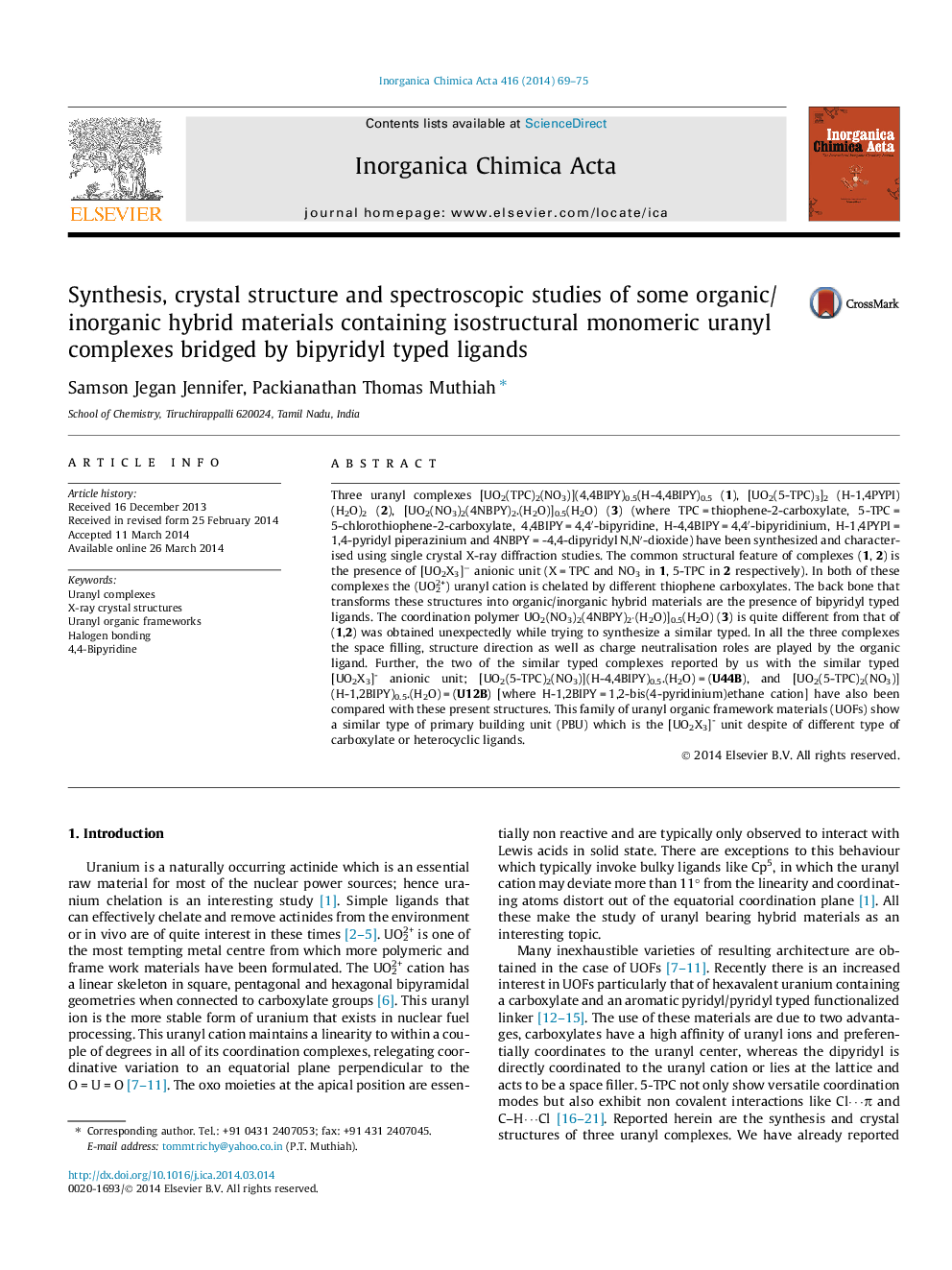| کد مقاله | کد نشریه | سال انتشار | مقاله انگلیسی | نسخه تمام متن |
|---|---|---|---|---|
| 1309954 | 1499172 | 2014 | 7 صفحه PDF | دانلود رایگان |
• Uranyl complexes (1 and 2) with 5-TPC and bipyridyl ligands are mononuclear.
• Uranyl complexes (1 and 2) with 5-TPC and bipyridyl ligands are isostructural.
• Uranyl complex (3) is a coordination polymer.
• Structure (2) form supramolecular architectures via hydrogen-bridged networks and halogen bonds.
Three uranyl complexes [UO2(TPC)2(NO3)](4,4BIPY)0.5(H-4,4BIPY)0.5 (1), [UO2(5-TPC)3]2 (H-1,4PYPI)(H2O)2 (2), [UO2(NO3)2(4NBPY)2.(H2O)]0.5(H2O) (3) (where TPC = thiophene-2-carboxylate, 5-TPC = 5-chlorothiophene-2-carboxylate, 4,4BIPY = 4,4′-bipyridine, H-4,4BIPY = 4,4′-bipyridinium, H-1,4PYPI = 1,4-pyridyl piperazinium and 4NBPY = -4,4-dipyridyl N,N′-dioxide) have been synthesized and characterised using single crystal X-ray diffraction studies. The common structural feature of complexes (1, 2) is the presence of [UO2X3]− anionic unit (X = TPC and NO3 in 1, 5-TPC in 2 respectively). In both of these complexes the (UO22+) uranyl cation is chelated by different thiophene carboxylates. The back bone that transforms these structures into organic/inorganic hybrid materials are the presence of bipyridyl typed ligands. The coordination polymer UO2(NO3)2(4NBPY)2·(H2O)]0.5(H2O) (3) is quite different from that of (1,2) was obtained unexpectedly while trying to synthesize a similar typed. In all the three complexes the space filling, structure direction as well as charge neutralisation roles are played by the organic ligand. Further, the two of the similar typed complexes reported by us with the similar typed [UO2X3]- anionic unit; [UO2(5-TPC)2(NO3)](H-4,4BIPY)0.5.(H2O) = (U44B), and [UO2(5-TPC)2(NO3)](H-1,2BIPY)0.5.(H2O) = (U12B) [where H-1,2BIPY = 1,2-bis(4-pyridinium)ethane cation] have also been compared with these present structures. This family of uranyl organic framework materials (UOFs) show a similar type of primary building unit (PBU) which is the [UO2X3]- unit despite of different type of carboxylate or heterocyclic ligands.
Three uranyl complexes [UO2(TPC)2(NO3)](4,4BIPY)0.5(H-4,4BIPY)0.5 (1), [UO2(5-TPC)3]2 (H-1,4PYPI)(H2O)2 (2), [UO2(NO3)2(4NBPY)2.(H2O)]0.5(H2O) (3) (where TPC = thiophene-2-carboxylate, 5-TPC = 5-chlorothiophene-2-carboxylate, 4,4BIPY = 4,4′-bipyridine, H-4,4BIPY = 4,4′-bipyridinium, H-1,4PYPI = 1,4-pyridyl piperazinium and 4NBPY = -4,4-dipyridyl N,N′-dioxide) have been synthesized and characterised using single crystal X-ray diffraction studies.Figure optionsDownload as PowerPoint slide
Journal: Inorganica Chimica Acta - Volume 416, 24 May 2014, Pages 69–75
